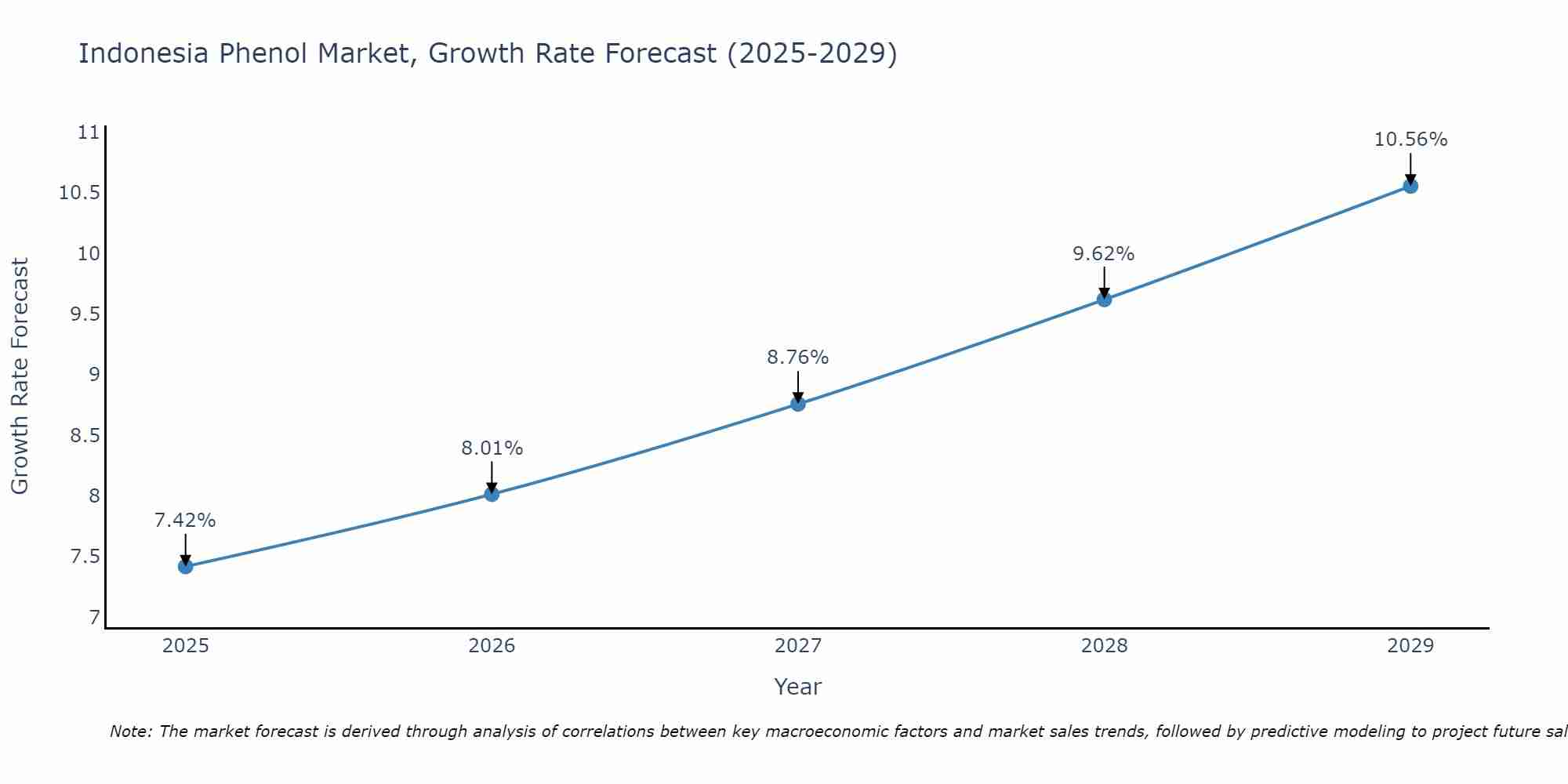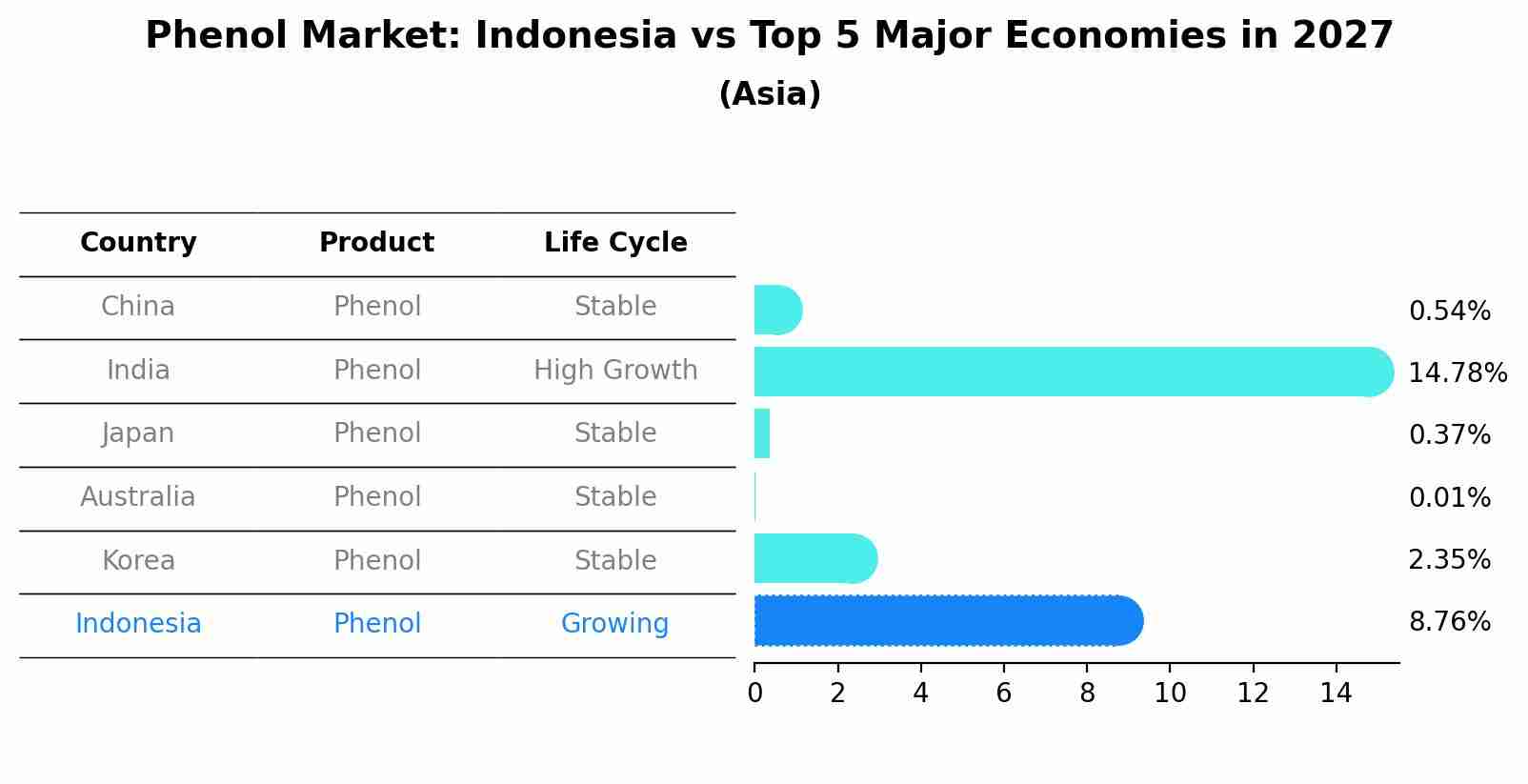Indonesia Phenol Market (2025-2031) Outlook | Value, Revenue, Analysis, Forecast, Size, Growth, Trends, Industry, Companies & Share
| Product Code: ETC108347 | Publication Date: Jul 2023 | Updated Date: Apr 2025 | Product Type: Report | |
| Publisher: 6Wresearch | No. of Pages: 70 | No. of Figures: 35 | No. of Tables: 5 | |
Indonesia Phenol Market Size Growth Rate
The Indonesia Phenol Market is likely to experience consistent growth rate gains over the period 2025 to 2029. Commencing at 7.42% in 2025, growth builds up to 10.56% by 2029.

Phenol Market: Indonesia vs Top 5 Major Economies in 2027 (Asia)
By 2027, Indonesia's Phenol market is forecasted to achieve a growing growth rate of 8.76%, with China leading the Asia region, followed by India, Japan, Australia and South Korea.

Indonesia Phenol MarketSynopsis
Phenol is a toxic, colorless crystalline solid that has a sweet smell and taste. It is widely used in the production of plastics, synthetic fibers, dyes, solvents and drugs. Phenol can also be found naturally in coal tar, crude oil and wood smoke. In Indonesia, phenol finds its use in various industries such as pharmaceuticals industry for manufacturing medicines; paints & coating industry to manufacture resins; plastic & rubber industry for producing polycarbonates; textile industry for making nylon fibers; adhesives industry to produce epoxy resins etc.
Market Trends
The demand for phenols has increased significantly over the past few years due to its wide range of applications across numerous industries ranging from pharmaceuticals to plastic & rubber industries. The Indonesia government?s focus on promoting investments in manufacturing plants along with support from international organizations has encouraged domestic producers as well as foreign investors to set up businesses in the country which further drives the growth of this market. Additionally, continuously expanding population coupled with growing purchasing power amongst Indonesias will lead an increase in consumption patterns driving domestic sales of chemicals including phenols.
Market Drivers
Increasing demand from end-use sectors like healthcare and automotive is expected to drive growth over forecast period owing to increasing disposable income among middle class population. Furthermore ,increasing need for eco friendly solutions shall provide positive towards growth opportunities.Moreover , rising trend towards green buildings may spur demand upsurge during forecast period. Growing urbanization shall foster higher construction activities augmenting market size till 2031.In addition ,rising personal care products production shall fuel product penetration over coming years thereby boosting overall revenue till 2031.Government initiatives towards industrial development are likely create lucrative opportunities by 2025 end across region particularly Indonesia.
COVID-19 Impact on the Market
The COVID-19 pandemic has had a severe impact on the Indonesia phenol market. Due to the disruption in supply chain and weak demand, market prices have declined significantly. Furthermore, due to decreased construction activity across the country, there has been a significant decrease in demand for phenol from downstream industries such as paints and coatings manufacturing.
Challenges of the Market
The major challenge faced by the Indonesia phenol industry is its high dependence on imports. The majority of raw materials used for producing phenol are imported from countries such as China and India. This makes it difficult for local manufacturers to compete with international players in terms of pricing and quality standards. Additionally, Indonesia does not have any domestic suppliers of feedstock needed for production resulting in higher costs associated with importing these materials.
Industry Key Players
Some of the key players operating in Indonesia phenol market include PT Pertamina (State Owned Oil & Gas Company), PT Deltapack Inti Corporindo (Plastic Packaging Manufacturer) , Indorama Ventures Public Limited Company (Chemicals Manufacturing Company), Sinar Mas Group (Agricultural Products Producer) , Asia Pacific Rayon (Rayon Fibre Manufacturer).
Key Highlights of the Report:
- Indonesia Phenol Market Outlook
- Market Size of Indonesia Phenol Market, 2024
- Forecast of Indonesia Phenol Market, 2031
- Historical Data and Forecast of Indonesia Phenol Revenues & Volume for the Period 2021-2031
- Indonesia Phenol Market Trend Evolution
- Indonesia Phenol Market Drivers and Challenges
- Indonesia Phenol Price Trends
- Indonesia Phenol Porter's Five Forces
- Indonesia Phenol Industry Life Cycle
- Historical Data and Forecast of Indonesia Phenol Market Revenues & Volume By End-users for the Period 2021-2031
- Historical Data and Forecast of Indonesia Phenol Market Revenues & Volume By Bisphenol A for the Period 2021-2031
- Historical Data and Forecast of Indonesia Phenol Market Revenues & Volume By Phenolic Resins for the Period 2021-2031
- Historical Data and Forecast of Indonesia Phenol Market Revenues & Volume By Caprolactam for the Period 2021-2031
- Historical Data and Forecast of Indonesia Phenol Market Revenues & Volume By Alkyl Phenyls for the Period 2021-2031
- Historical Data and Forecast of Indonesia Phenol Market Revenues & Volume By Others for the Period 2021-2031
- Indonesia Phenol Import Export Trade Statistics
- Market Opportunity Assessment By End-users
- Indonesia Phenol Top Companies Market Share
- Indonesia Phenol Competitive Benchmarking By Technical and Operational Parameters
- Indonesia Phenol Company Profiles
- Indonesia Phenol Key Strategic Recommendations
Frequently Asked Questions About the Market Study (FAQs):
1 Executive Summary |
2 Introduction |
2.1 Key Highlights of the Report |
2.2 Report Description |
2.3 Market Scope & Segmentation |
2.4 Research Methodology |
2.5 Assumptions |
3 Indonesia Phenol Market Overview |
3.1 Indonesia Country Macro Economic Indicators |
3.2 Indonesia Phenol Market Revenues & Volume, 2021 & 2031F |
3.3 Indonesia Phenol Market - Industry Life Cycle |
3.4 Indonesia Phenol Market - Porter's Five Forces |
3.5 Indonesia Phenol Market Revenues & Volume Share, By End-users, 2021 & 2031F |
4 Indonesia Phenol Market Dynamics |
4.1 Impact Analysis |
4.2 Market Drivers |
4.3 Market Restraints |
5 Indonesia Phenol Market Trends |
6 Indonesia Phenol Market, By Types |
6.1 Indonesia Phenol Market, By End-users |
6.1.1 Overview and Analysis |
6.1.2 Indonesia Phenol Market Revenues & Volume, By End-users, 2021-2031F |
6.1.3 Indonesia Phenol Market Revenues & Volume, By Bisphenol A, 2021-2031F |
6.1.4 Indonesia Phenol Market Revenues & Volume, By Phenolic Resins, 2021-2031F |
6.1.5 Indonesia Phenol Market Revenues & Volume, By Caprolactam, 2021-2031F |
6.1.6 Indonesia Phenol Market Revenues & Volume, By Alkyl Phenyls, 2021-2031F |
6.1.7 Indonesia Phenol Market Revenues & Volume, By Others, 2021-2031F |
7 Indonesia Phenol Market Import-Export Trade Statistics |
7.1 Indonesia Phenol Market Export to Major Countries |
7.2 Indonesia Phenol Market Imports from Major Countries |
8 Indonesia Phenol Market Key Performance Indicators |
9 Indonesia Phenol Market - Opportunity Assessment |
9.1 Indonesia Phenol Market Opportunity Assessment, By End-users, 2021 & 2031F |
10 Indonesia Phenol Market - Competitive Landscape |
10.1 Indonesia Phenol Market Revenue Share, By Companies, 2024 |
10.2 Indonesia Phenol Market Competitive Benchmarking, By Operating and Technical Parameters |
11 Company Profiles |
12 Recommendations |
13 Disclaimer |
- Single User License$ 1,995
- Department License$ 2,400
- Site License$ 3,120
- Global License$ 3,795
Search
Related Reports
- Portugal Electronic Document Management Market (2025-2031) | Strategy, Consumer Insights, Analysis, Investment Trends, Opportunities, Growth, Size, Share, Industry, Revenue, Segments, Value, Segmentation, Supply, Forecast, Restraints, Outlook, Competition, Drivers, Trends, Demand, Pricing Analysis, Competitive, Strategic Insights, Companies, Challenges
- France Electronic Document Management Market (2025-2031) | Strategy, Consumer Insights, Analysis, Investment Trends, Opportunities, Growth, Size, Share, Industry, Revenue, Segments, Value, Segmentation, Supply, Forecast, Restraints, Outlook, Competition, Drivers, Trends, Demand, Pricing Analysis, Competitive, Strategic Insights, Companies, Challenges
- Portugal Occupational Health & Safety Services Market (2025-2031) | Strategy, Consumer Insights, Analysis, Investment Trends, Opportunities, Growth, Size, Share, Industry, Revenue, Segments, Value, Segmentation, Supply, Forecast, Restraints, Outlook, Competition, Drivers, Trends, Demand, Pricing Analysis, Competitive, Strategic Insights, Companies, Challenges
- Netherlands Occupational Health and Safety Services Market (2025-2031) | Strategy, Consumer Insights, Analysis, Investment Trends, Opportunities, Growth, Size, Share, Industry, Revenue, Segments, Value, Segmentation, Supply, Forecast, Restraints, Outlook, Competition, Drivers, Trends, Demand, Pricing Analysis, Competitive, Strategic Insights, Companies, Challenges
- Belgium and Luxembourg Facility Management Market (2025-2031) | Strategy, Consumer Insights, Analysis, Investment Trends, Opportunities, Growth, Size, Share, Industry, Revenue, Segments, Value, Segmentation, Supply, Forecast, Restraints, Outlook, Competition, Drivers, Trends, Demand, Pricing Analysis, Competitive, Strategic Insights, Companies, Challenges
- Russia Women Intimate Apparel Market (2025-2031) | Strategy, Consumer Insights, Analysis, Investment Trends, Opportunities, Growth, Size, Share, Industry, Revenue, Segments, Value, Segmentation, Supply, Forecast, Restraints, Outlook, Competition, Drivers, Trends, Demand, Pricing Analysis, Competitive, Strategic Insights, Companies, Challenges
- Africa Chocolate Market (2025-2031) | Size, Share, Trends, Growth, Revenue, Analysis, Forecast, industry & Outlook
- Global Hydroxychloroquine And Chloroquine Market (2025-2031) | Industry, Trends, Size, Outlook, Growth, Value, Companies, Revenue, Analysis, Share, Forecast
- Saudi Arabia Plant Maintenance Market (2025-2031) | Industry, Size, Growth, Revenue, Value, Companies, Forecast, Analysis, Share & Trends
- Taiwan Electric Truck Market (2025-2031) | Outlook, Industry, Revenue, Size, Forecast, Growth, Analysis, Share, Companies, Value & Trends
Industry Events and Analyst Meet
Our Clients
Whitepaper
- Middle East & Africa Commercial Security Market Click here to view more.
- Middle East & Africa Fire Safety Systems & Equipment Market Click here to view more.
- GCC Drone Market Click here to view more.
- Middle East Lighting Fixture Market Click here to view more.
- GCC Physical & Perimeter Security Market Click here to view more.
6WResearch In News
- Doha a strategic location for EV manufacturing hub: IPA Qatar
- Demand for luxury TVs surging in the GCC, says Samsung
- Empowering Growth: The Thriving Journey of Bangladesh’s Cable Industry
- Demand for luxury TVs surging in the GCC, says Samsung
- Video call with a traditional healer? Once unthinkable, it’s now common in South Africa
- Intelligent Buildings To Smooth GCC’s Path To Net Zero













